Software Application Development: Detailed Guide
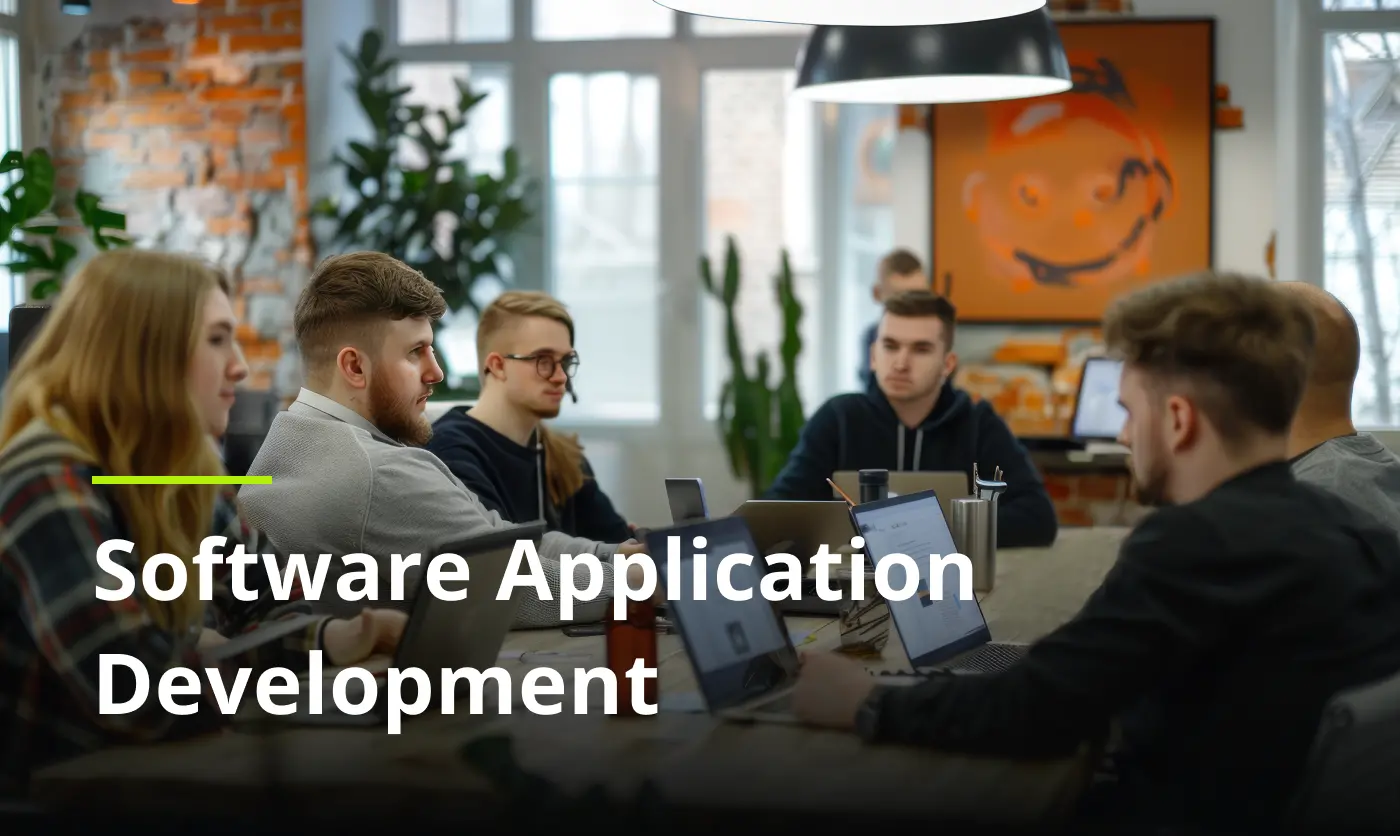
Software application development is an important area of specialization, which entails the conceptualization and development of software applications geared towards specific requirements. Whether it aims at improving organizational processes or offering advanced instruments to consumers, the development of software applications is based on the concept of bringing value to users and the goal to create novel concepts to foster growth and efficiency.
In the sphere of software application programming, the concentration is also given to the creation of a diverse number of apps for different platforms and users’ demands. This requires complex coding activities, designs of user interfaces and other aspects of integration to produce a well nutritious output.
Thus, when developing software application, the knowledge of the definition, budget and trends is critical to achieving success when. In the following article we will examine in more detail the ins and outs of managing the complexity involved in making software application and uncover how to turn a project into a resounding success.
What is software application development?
The development of the software application here refers to the process of crafting an application that will fit the need of a certain user or solve a specific problem. It entails a rigorous sequence of processes from the conceptualization and planning phase right down to the nitty-gritty of coding and launch so that the software in use performs and is useful to the intended consumers.
Application development software may be as simple as any tool or utility or as complex as programs or systems supporting various business processes. Thus, the main goal is to provide the application that works properly, stably and is convenient for the intended use and satisfies the users.
Such applications may be simple and include some utilities while in other cases they are complex programs that incorporate multiple functions that are useful to people in their everyday lives or in their businesses.
Thus, a great deal of planning, coding and testing goes into software application programming so that the final product will not disappoint or fail in performance. These concerns might be based on such aspects as usability, security and more during the entire process of development. Using complex languages and frameworks that are available in the market developers can produce sophisticated apps that have good graphical user interfaces giving consumers an enjoyable time.
Ultimately, the desired output of such an undertaking is an optimized software app that is both efficient and intuitive keeping pace with the evolving digital world.
Types of development for application software
The development of software apps appeals to a wide variety of technologies and platforms, each having its own special features and cases of use. The following paragraphs will highlight the different kinds of software app development: web and mob apps, desktop programs, game development, enterprise software and lastly embedded systems.
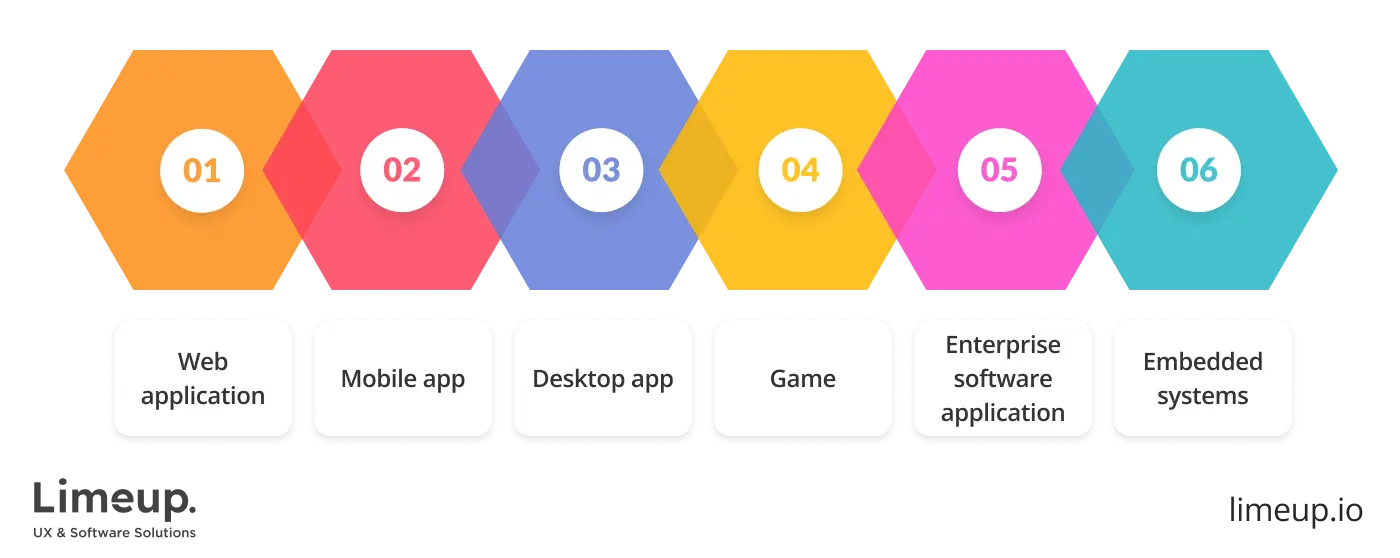
Web application development
Web app development mainly deals with the creation of programs that are embedded in browser environments and are accessible via the Internet. Such applications are developed with the help of technologies as HTML, CSS, JavaScript and web frameworks React or Angular. Web apps do not depend on the operating system and can run on any device presenting a similar appearance of the interface.
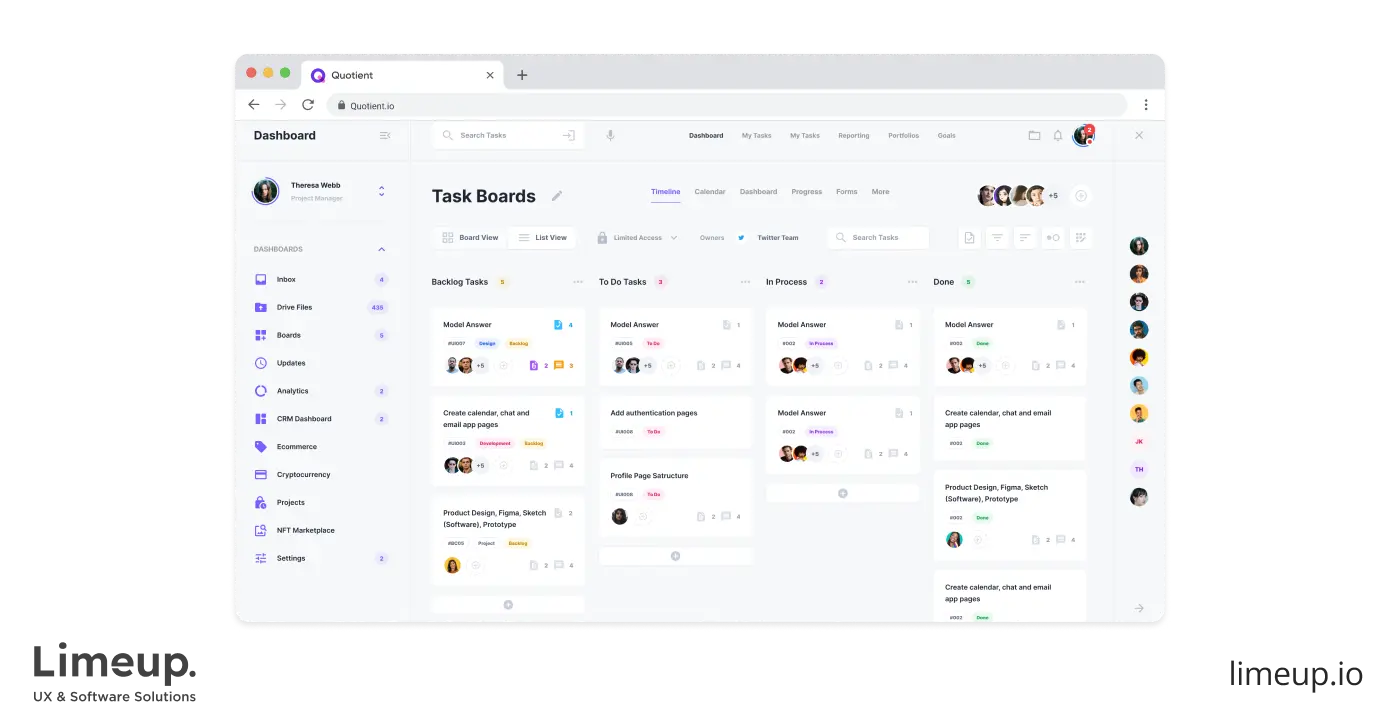
They are ideally suited for businesses that wish to provide service delivery without the need for a respective program to be installed on user’s device — it may be as small as a website or as large as an app such as an e-commerce platform or social network sites being convenient and easy to reach.
Mobile app development
Mobile application development software is the process of developing software apps that are cut out for small portable devices such as hand-held smartphones and tablets. There are 3 primary types of mobile apps: native, hybrid and web-based. Native apps are developed for certain platforms like iOS or Android using languages of the relevant system. Hybrid apps blend native and web features since they may be deployed in both operating systems.
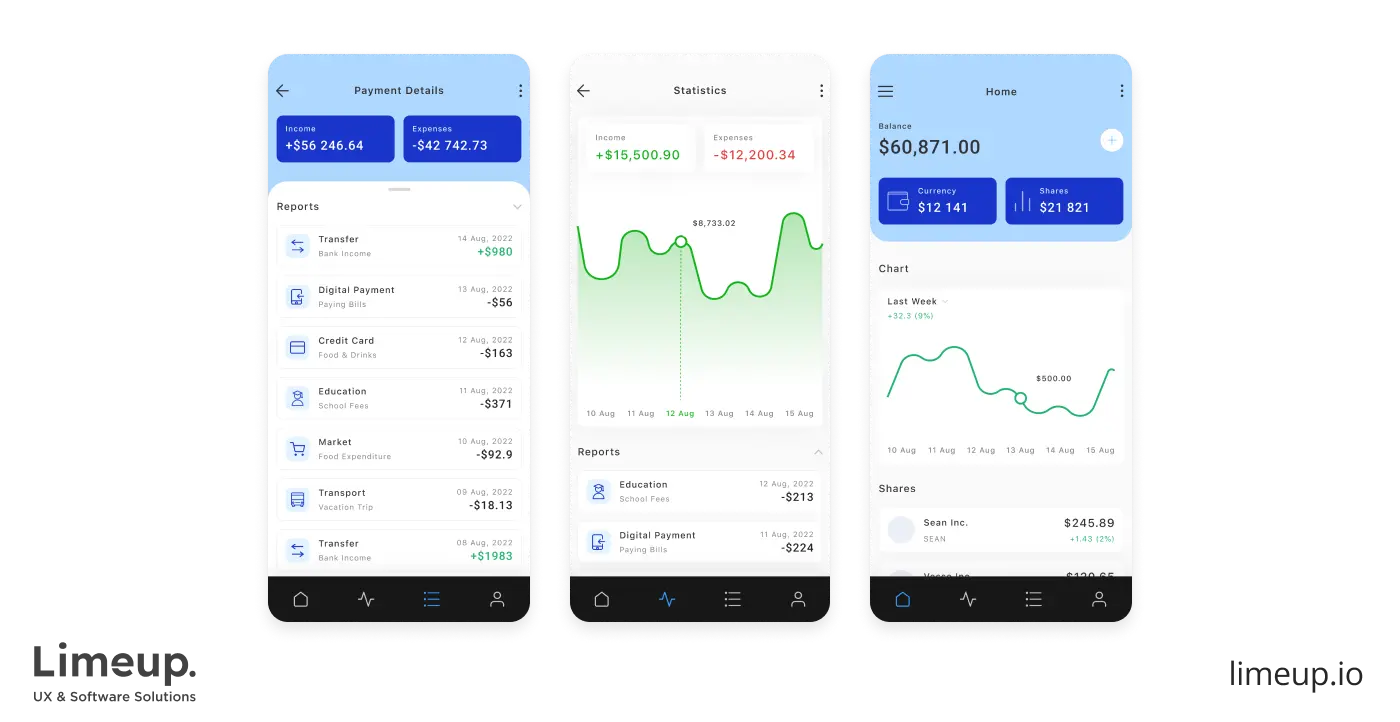
On the other hand web-based applications are those accessed via mobile browser and made using web technologies. Mobile apps are pivotal for businesses focused on mobile users, honing in on optimizing performance and enhancing user experience in a mobile context.
Desktop app development
Desktop app development means the software application engineering that will be installed on personal computers or workstations. These apps are loaded on the user’s device and are usable offline, they do not necessarily have to be run through a web browser. Programming languages that are usually associated with desktop applications are C++, Java and Python.
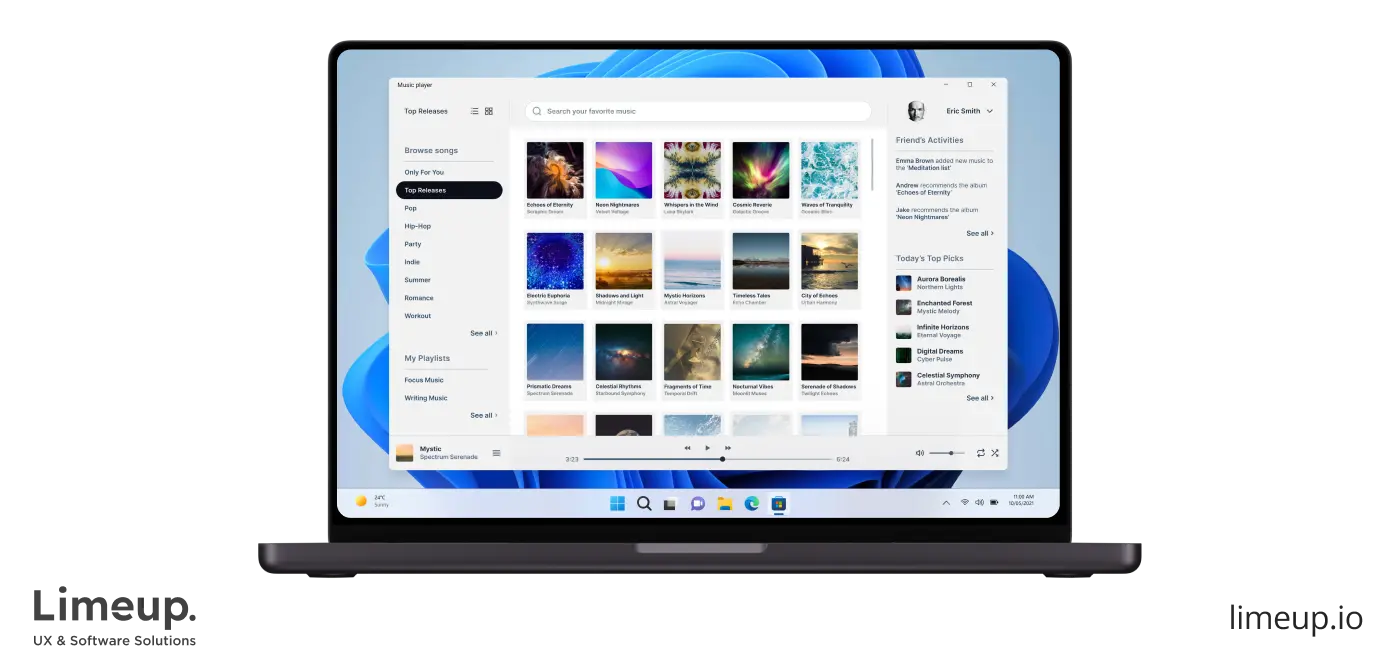
Desktop apps may range from good old office productivity tools and photo editing programs to games. They are usually expected to take advantage of the hardware on which any of them will be resident and deliver top performance with well built functions.
Game development
This branch of computer science involves the construction of interactive entertainment software for computers, gaming consoles and portable gadgets. To work in this field, you need to combine the artistry of mind with the practical skill of coding using game engines such as Unity or Unreal engine.
The process of developing a game may be divided into several phases: concept, design, coding, testing and deployment pulling in programmers, artists, designers and testers together. For the purpose of helping the user to remember the product, it centers around giving the audience an exciting story, bright graphics and a high level of game control.
Enterprise software application development
Enterprise development of application software deals with the creation of large-scale software apps supporting the business and organizational processes. Such applications are aimed at increasing productivity, optimizing work processes and facilitating the functioning of enterprises. Some of these applications are customer relationship management (CRM) systems, enterprise resource planning (ERP) systems and human resource management systems.

The systems used in enterprises are most of the time complex solutions that require to be secure, flexible and integrated with other systems. These applications are backbone for organizations handling and controlling various operations and processes to keep everything running like a clockwork.
Embedded systems development
Developing embedded systems incorporates the delivery of software for embedded systems which are specialized computing systems designed to perform a few dedicated operations within larger systems. By and large, an embedded system may be found in almost any device from home appliances and automotive systems to medical equipment and industrial machines.
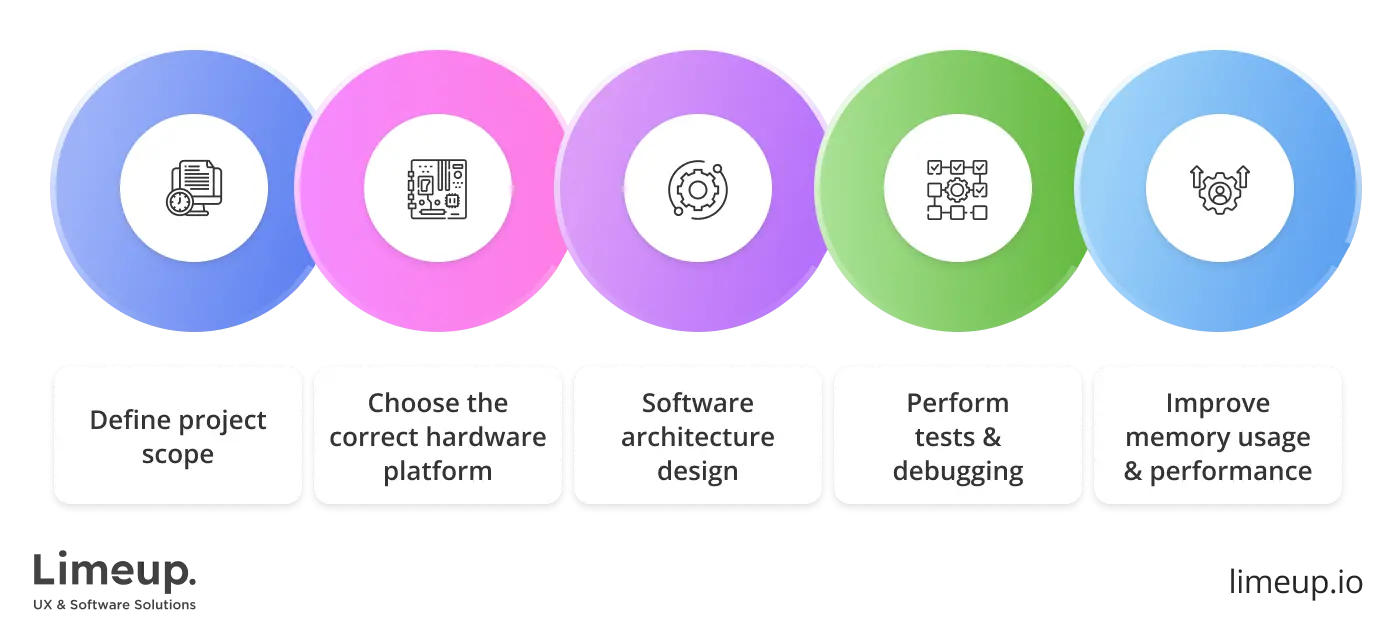
It is primarily developed with languages like C or C++ and at the same time it has very strong requirements for high performance, reliability and real time operation. Development involves the writing of code directly for hardware components to ensure the system runs efficiently and safely. Inbuilt systems play a very indispensable role in functionality and innovation in many of today’s devices.
What budget do you need for developing software application?
What is the price for software development — the short answer will of course be between $10,000 and $250,000. However, the final estimate will have to be based on variables such as the complexity of the project, programming platforms, UX/UI design, the tech stack chosen and APIs. Notably, the location of the application software development team and the type of partnership arrangement are critical factors.
The software pricing depends on the functionalities and the number of features it offers. Not all functionalities will have varying charges for implementation. An excellent example would be video calls or even push notifications, which are at very different price ranges since they take so much time to be complex in code. Different resources are needed for complex real-time data analytics with many authorization levels than, say, a fitness app with a calorie calculator.
Therefore we may clarify how the cost of developing a software app fluctuates based on:
- Size of app
- The complexity of the app
- Technologies used
- Amount of features that the client wants to add to the app
- A number of team members and hiring methods: in-house, freelance, outsourcing
Now, let us get into detail about the major factors influencing the cost of software app development.
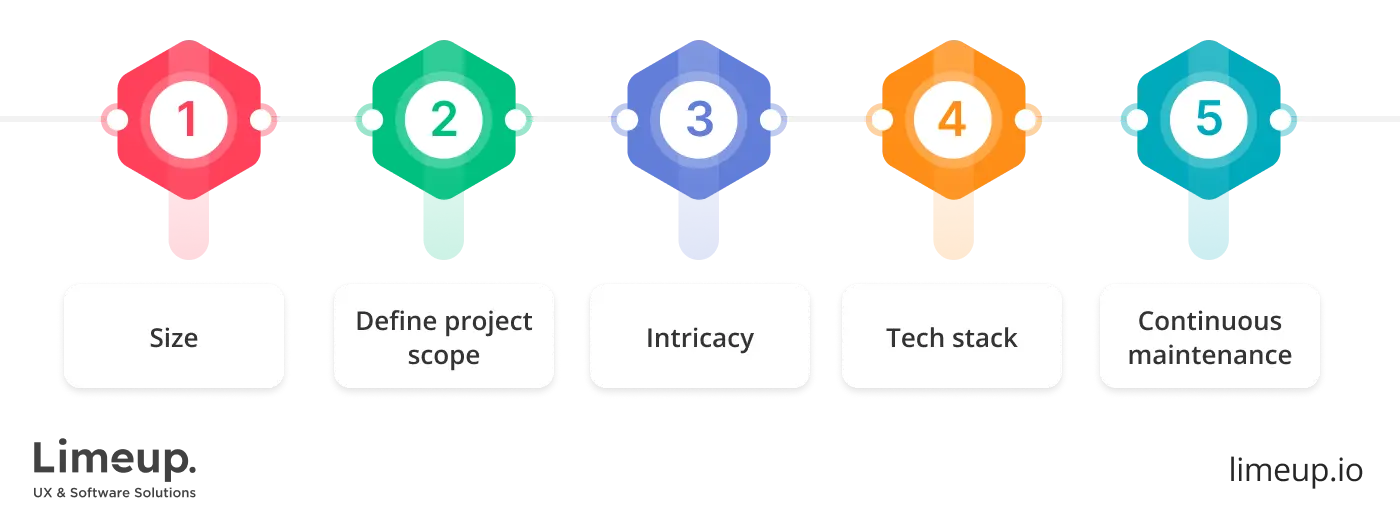
Size. In order to describe the size of software, we must first comprehend what a screen means in this particular situation. A screen is a page, open menu, or anything which a user sees after they make an interaction. For example, a login page and change password page are two different screens, performing different functions. In this regard, the size factor is simple — the more the number of screens the software has, the more the cost of the software project will be.
The general range for small apps would fall somewhere in the range of 10 to 25 screens and run upwards of $75,000. More extensive projects with 50-plus screens may be as much as $250,000 or higher.
Intricacy. The complexity of the application depends on features and the kind of UI design the customer chooses. All this requires careful planning — your app will be hard to build if you want sophisticated animations and complex user interactions in a customized application. This complexity also increases when your software has to integrate with third-party services, API, social networking sites, online payment gateways and others.
Tech stack. Cross-platform development will definitely be a preference if you want to develop an app running on multiple platforms at a time; otherwise, both the production time and money invested in software and application development will increase manifolds. This is so because code, optimization and testing for three desktop programs (Windows, macOS, Linux) or two mobile apps (iOS and Android) need to be platform-specific.
Some apps could be written using only a single API. Others require that the backend be written in one language and the frontend in another — all of which must work seamlessly together.
Team. The type of your software development team will dictate how much they charge. You will save a lot on the development of software if your business already has a dedicated IT staff. However, after a while, it will also turn out to be expensive since you continue paying for them. Not to mention, many existing teams are not well-staffed or lack the necessary expertise.
In such a case, you are then able to outsourcing the work or training a new team which you introduce into your staff. This is somewhat expensive as compared with the other three but as you have noted, you are going to gain a much better quality project. Introduce straightforward questions in relation to the development process of the software and the program to your prospective team members.
Continuous maintenance. There is always room for improvement in functionality, speeding up and fixing of hidden bugs. We will discuss this benefit of the time and material payment model more as a separate point later in this article. You have the capacity to change things before seeing the final product.
There’s a proverb in the industry that all costs should be tripled. That mostly happens due to people choosing a fixed-price payment model without knowing what they want to achieve with the project. They must pay more since they receive a product that is nothing like what the client had in mind.
Web development vs. software app development
Essentially, web development is about developing applications that are run in the browsers and are thus usable from any device anywhere connected to the internet, while software app creation deals with applications installed and running natively on operating systems.
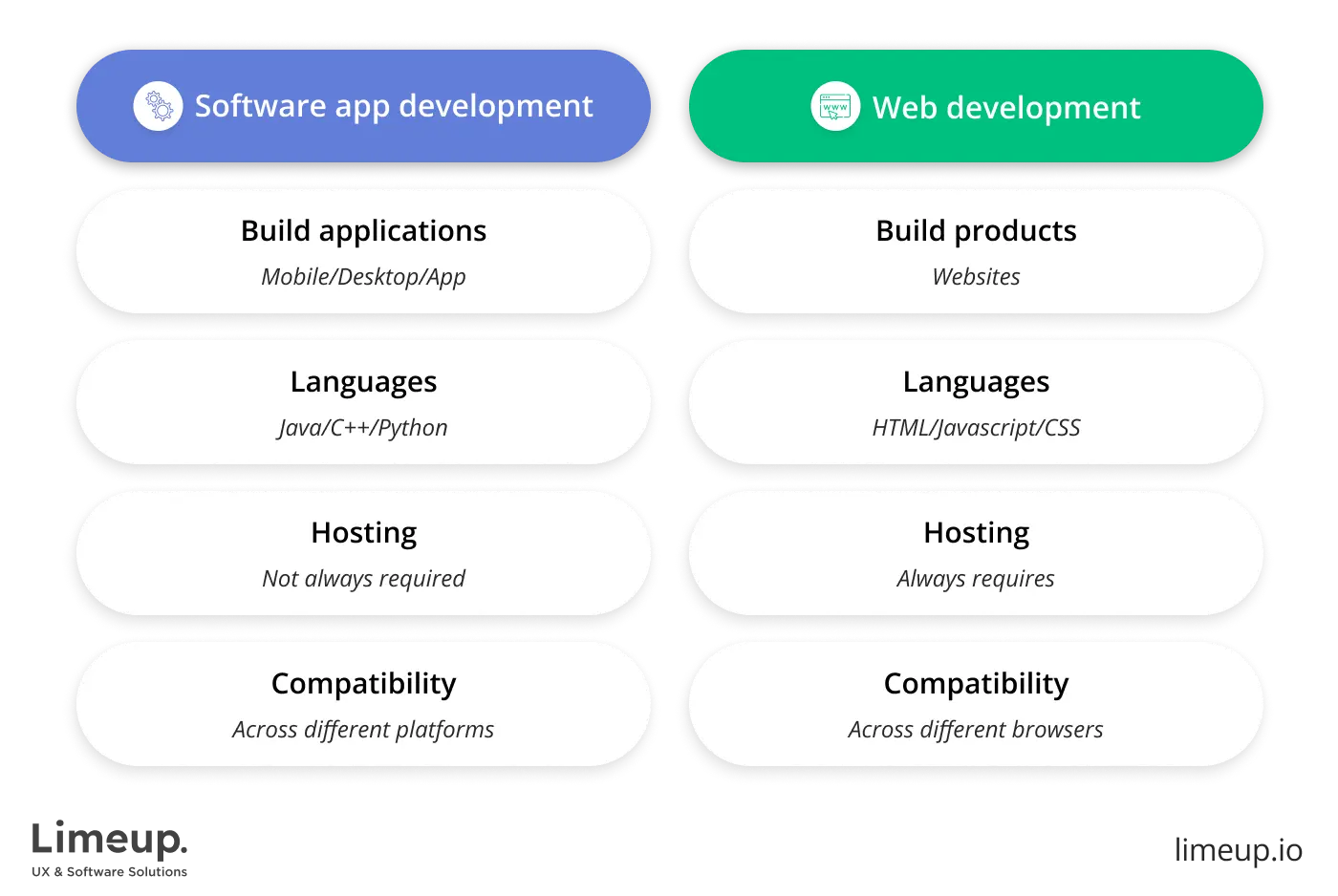
Web development refers to the process of continuously designing, developing and maintaining websites through reliable development and deployment. It is concerned with database management, web development, web design and content management. This technique revolves around creating an online application for information provision, like a website.
In addition, there are two types of web development: frontend and backend. The frontend of a website refers to the process of developing the user-facing interface displayed to visitors. It is also referred to as the “client side” of the application. Conversely, the backend refers to the server side of a webpage — it is that part of the website in question that visitors would not see or use.
The result of development in software applications includes a functional, reliable, user-oriented software product, suiting running with intended requirements and solving problems. These products can range from desktop applications or web applications to mobile apps, all designed to run in their respective environments.
As far as software application development is concerned, we have already mentioned the definition of what it is but let’s compare it now with web development with the help of the following table.
| Aspect | Web development | Software app development |
| Scope | Develops applications and websites for browsers | Develops standalone applications for desktops or servers |
| Technologies | HTML, CSS, JavaScript, frameworks (React, Angular, Vue.js), server-side languages (PHP, Python, Node.js) | Languages (C++, Java, .NET, Python), frameworks, installers |
| User experience | Responsive design for various screen sizes, accessed via URLs, requires an internet connection | Optimized for specific operating systems, installed directly on devices, may work offline |
| Platform | Platform-independent, accessible via any web browser | Platform-specific (Windows, macOS, Linux, etc.) |
| Distribution | Delivered via web URLs, no installation required | Distributed via installers or executables |
| Development focus | Ensures cross-device and cross-browser compatibility | Deals with performance and integration into specific operating system |
Challenges of building software applications
The tech industry is dynamic and ever-changing — it’s a domain where pushing boundaries and finding new solutions to complex problems is a day-to-day activity.
The development of software products is an area of tough challenges and high demands that form the very heart of the IT industry. Thus, engineering teams would definitely have to face various issues that would bring a standstill to software engineering projects or sometimes even delays.
To help you effectively manage the entire software product development process with little or no frustration, here is a list of the major challenges you typically encounter.

Continuous progress in technology. Improving technology poses a challenge to the development of software apps since it means that for a business to be competitive, it has to move at the same speed as changing technologies. A good software application development company tackles this problem by having its members learn new things and become innovative all the time.
They invest in continuous training programs, foster industry participation and importantly, accord flexibility and scalability the top priority in their development processes to enable themselves to pick up new technologies fast enough in response to changing market needs.
Platform intricacy. Platform complexity occurs when software needs to be developed for many platforms, which implement several requirements and technologies, namely iOS, Android and web. A good software development company in the UK is able to only address such a challenge through cross-platform development frameworks like Flutter or React Native.
These frameworks save developers the trouble and effort when writing the code for one time and then making it run on multiple platforms, hence saving time.
Security. The challenge that a software application development company has to face is to provide robust data security so that confidential information may not be accessed by any unauthorized access. An app creation company is needed to deploy several cryptographic techniques for data security while in motion and at rest.
Additional safeguards are provided to the software program through the adoption of secure coding practices and thorough security testing to prevent vulnerabilities and guarantee data confidentiality and integrity throughout the development life cycle.
Changing needs. Requirements changes impede software development and result in scope creep, delays and increased costs. Here your IT partner will need to implement the Agile methods, either Scrum or Kanban to deal with the challenge. They assign the greatest significance to the communication with the customer for the observation of new needs and for the immediate reaction to these changes.
They avail consistent version control systems and the testing system so that the program does not become a work in progress due to unsounded needs. Specialist app development companies in the UK use methods of empowered requirement and flexible change management to apply principles to provide effective changes in response to the actual needs of their clients.
Time constraints. Under time constraints, in the field of software application development services, projects are usually rushed; this automatically translates to lower quality and raises the possibility of failure. Reputed app development companies overcome this challenge by adopting effective project management techniques to prioritize, optimize workflows and allocate resources most efficiently.
They also bring already-purchased frameworks, automation tools as well as reusable components for quicker delivery of the development work or this development process without the compromise of quality. Hence, by the use of the iterative development cycle, realistic time frames and openness in communicating the software development progress, these companies are able to be in a position to deliver within the required timeframe quality software solutions.
Software testing conflicts. To this effect, software testing conflicts arise when the software application engineering and testing teams fail to communicate well or when the priority levels of the two are different. Your service provider will promote a collaborative culture where both teams work closely together throughout the whole development cycle, which shall help in combating this.
They strongly emphasize early and continuous testing, incorporate testing into the development process, and, where feasible, automate tests. Development and testing are aligned with open lines of communication, frequent meetings and common objectives.
Future trends in software application programming
The way people envision, create and maintain software has begun changing at a high pace — from no-code apps to generative AI. Where will technology and software take us into the near future? Here are the most relevant trends in software development today:
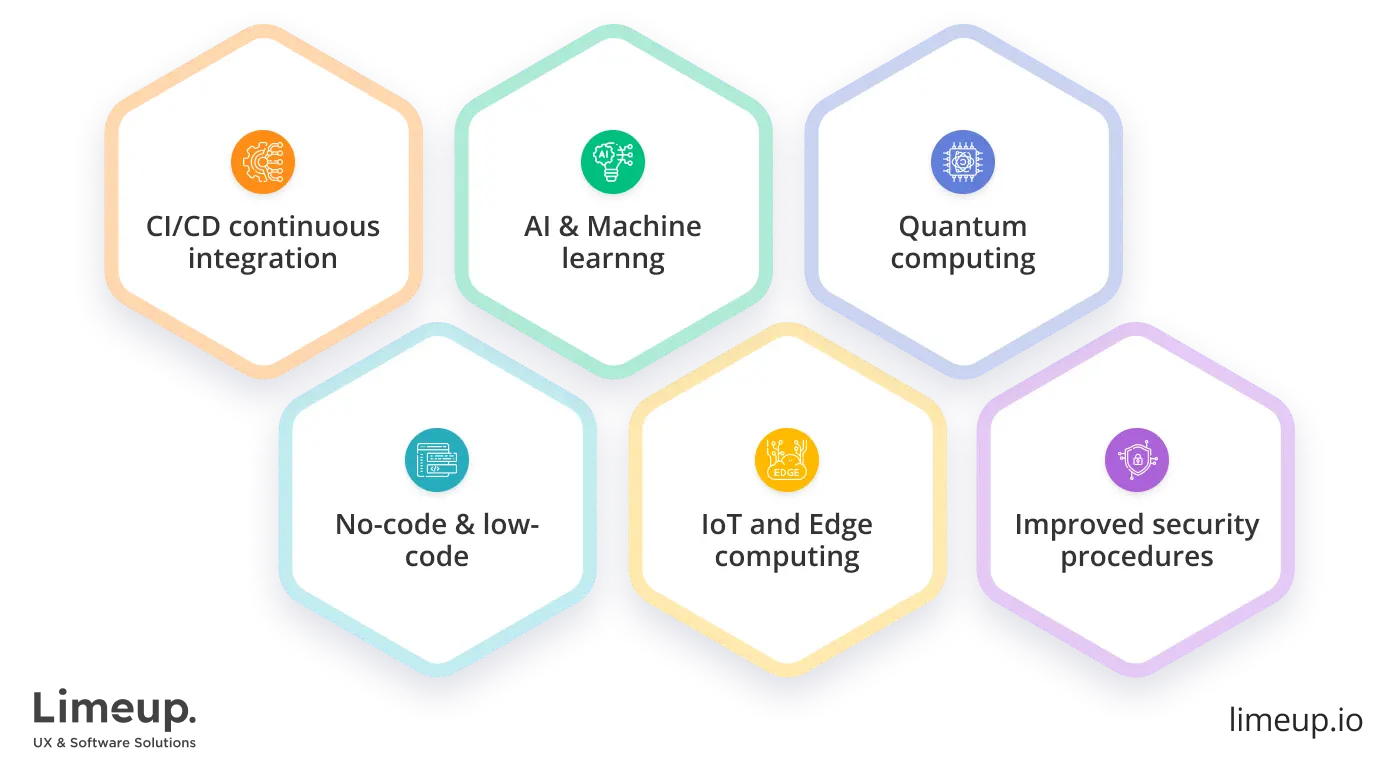
- CI/CD continuous integration/Continuous deployment and DevOps
The application of DevOps practices and CI/CD pipelines today is nourishing a mindset of collaboration among developers and operations teams and is rapidly becoming the rule in modern software development applications. The practices promise enriched quality, better reliability and faster delivery of software updates and features.
And going forward, further streamlined into DevOps, maybe some would say AIOps. AI-based automated monitoring and managing of CI/CD pipelines, coupled with proactive problem-solving and predictive maintenance, results in more seamless deployments with less downtime.
- Artificial intelligence and machine learning
Artificial intelligence and machine learning already show changes in software development; with new trends anticipated to continue, AI-powered technologies automate regular coding jobs, freeing up software application developers to concentrate on more complex problems and creative elements of development. On the other hand, ML algorithms are improving user experience through individualized software interactions, while predictive analytics may help foresee errors and risks.
We may see AI playing an even bigger part in the future. Such things as automated bug fixes, smart project management and live code completions may become norm of development environments infused by AI in the nearest future bringing increased productivity of development teams and cutting the time for development to mere fractional values.
- Quantum computing
While traditional computers operate with classical algorithms, quantum computers work with quantum algorithms helping a lot in software development applications, and since they process vast numbers of data operations at incredibly fast, they enable the solutions of problems that classical computers cannot solve at the moment.
We can expect that as the technology matures, new programming paradigms and languages will be invented to exploit the power of quantum computing. This shall make it necessary for developers to learn new techniques and get accustomed to such paradigms, hence resulting in a number of innovations in complex simulations, cryptography and optimization.
- Development using no-code and low-code
The usage of low-code and no-code software application engineering platforms has been increasingly rising due to this gap of demand for software and limited developers. These platforms reduce the role of real coding as users design the applications without much having to write the applications like real developers do.
These platforms will advance in sophistication in the future, making it possible to create sophisticated applications without a high level of technical expertise. Businesses will be able to innovate and quickly adjust to market changes thanks to the democratization of software development, which will remove the barrier of a lack of developers.
- IoT and Edge computing
It is the growth of Internet of Things devices that is really creating the need for edge computing, where data processing takes place closer to the source of data, rather than in some centralized data centers. This pattern results in faster and more effective handling of data, as latency and bandwidth consumption go down.
It simply means developers will have to develop apps that process data in real-time and decentralized situations. The need for edge-native app development will surge more and more, above all, in industries such as manufacturing, healthcare and smart cities.
- Improved security procedures
Security remains highly valued in software development application because cyber threats continue to grow. Early integration of security practices in the development lifecycle is the future trend that DevSecOps is taking. Thus, it is possible to make certain that security ceases to be an add-on to development but, rather, become s an inherent aspect of the development process.
Such security measures on an individual level will clearly fit with the application of artificial intelligence and machine learning-motivated intelligent systems capable of identifying a threat and defending against it. Besides, blockchain technology is capable of introducing new approaches to the means of transaction and data protection, so giving programmers effective tools for protecting applications.
Conclusion
In the overall process of creating software applications, there is no chance to be perfect, it is a process of improvement constantly. Nurturing a well thought out and visually appealing software then guarantees that applications are created to perform as they should while at the same time being aesthetically pleasant.
From the very moment when possessing only an idea for developing software applications to the moment it is turned into a product and further, to the moment when the client and the end consumer require support and additional services, the emphasis is made on the fact that expected results are simple, effective, unique and that they create a path for users to follow in order to obtain the desired outcome.
The life cycle is a stringent model of planning, designing and coding an application followed by its implementation and testing in the intended environment to make sure that all applications work properly. Acting according to the industry’s standards and being attentive to progressions in technologies, software development companies in London produce effective systems that may be easily altered to correspond to clients’ requirements and ever-shifting market conditions.
Finally, the application of software grows and prospers through efficiency in responding to problems in society that assure individuals a pleasant, seamless and interactive experience from a software application.
Thus, software app developers equip the software of today under the consideration of the most innovative techniques and with the direct endeavor to consider and conquer challenges, building a product that can endure the trials of both time and the utilization of technologies that have yet to be developed.

